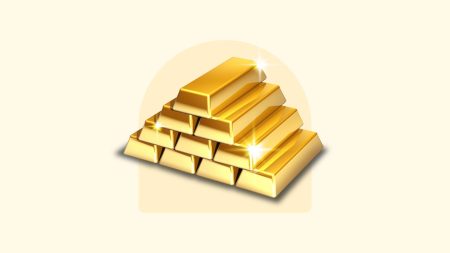Exchange-traded funds, or ETFs, are an increasingly popular way to invest in the financial markets. An ETF holds stakes in many different assets, and by buying a share of the fund, you own a tiny position in each of its holdings. With ETFs, investors can easily create a diversified portfolio and many funds charge only a modest fee while offering some great benefits.
If you’re looking to invest in ETFs, here’s how to get started with them.
What is an ETF?
Like a mutual fund, an ETF holds positions in many different assets, typically stocks or bonds. The holdings usually track a preset index such as the Standard & Poor’s 500 or the Dow Jones Industrial Average, rather than actively investing. So, ETFs are typically passive investments. And the fund’s wide holdings provide diversification, reducing – but not eliminating – risk.
ETFs are often focused around a specific kind of asset, investing in a specific collection of stocks, such as value or growth stocks, specific countries or industries, among other possible categories. This allows investors to buy a fund that offers them targeted exposure to the kinds of assets they want.
ETFs charge a fee for this service based on a percentage of money invested in the fund. For example, in 2022 the average stock index ETF charged 0.46 percent annually, or about $46 for every $10,000 invested, according to the Investment Company Institute. But you can find funds that charge much less, even just a few dollars, and this low cost as well as their convenience make ETFs very popular for investors.
Here’s the full rundown on ETFs, their advantages and disadvantages.
How to buy an ETF
ETFs trade on the stock exchanges just like a normal stock. Here’s how to invest:
1. Determine which ETF you want to buy
The U.S. market has thousands of ETFs trading, so you need to know what you want to buy. Figuring out which ETF you want may take some work. ETFs based on major indexes are good options for beginners. They offer broadly diversified exposure to some of the market’s best companies. Even legendary investor Warren Buffett recommends investors purchase an index fund tracking the S&P 500, which includes hundreds of America’s largest firms. Pay particular attention to the ETF’s expense ratio, which tells you how much you’ll pay as a management fee.
Note the ETF’s ticker symbol, a short code of three or four letters, because you’ll need it later.
2. Figure out how much to invest
How much can you invest in your ETF? It doesn’t take a lot to get started, and these days the best brokers allow you to buy fractional shares with no trading commission. This means you can go pick up a share of an ETF or part of a share with some of your spare change.
You build wealth over time by continuing to add money to the market. When you’ve figured out how much you can invest now, determine how much you can invest regularly, say, each month. Then commit to adding that money to your portfolio and growing your nest egg.
3. Place the order with your brokerage
Finally, turn to your broker to place an order. If you don’t have a brokerage account, it often takes just a few minutes to open one, and a handful of brokers such as Robinhood will let you get started immediately, and even let you fund your account instantly.
If you have money in your account already, you can place the trade using the ticker symbol and then buy shares or partial shares.
Pros and cons of investing in ETFs
ETFs offer some major advantages and a handful of disadvantages to investors. Here are some of the most important.
Pros of ETFs
- Low cost. ETFs are one of the best ways to invest in a diversified portfolio and to do so at a low cost. Sometimes it may cost you just a few dollars for every $10,000 you have invested.
- No trading commissions at online brokers. Nearly all major online brokers do not charge any commissions for trading ETFs.
- Priced throughout the day. ETFs are priced and exchanged throughout the trading day, giving investors flexibility to act as news arises.
- Passively managed. ETFs are usually (but not always) passively managed, meaning they simply follow a preselected index of stocks or bonds. Research shows that passive investing tends to beat active investing most of the time, and it’s also a cheaper approach, so the fund company passes much of those savings to investors.
- Diversification. An ETF typically allows you to buy dozens of assets in one fund, meaning you get diversification (and lower risk) than if you bought just one or two stocks.
- Focused investments. ETFs are usually focused on a specific niche, such as investing style, industry, company size or country. So, you can buy an investment focused on a specific area such as biotechnology, if you think it’s poised to go up.
- Large investment choice. With thousands of ETFs available, you have a lot of options to potentially invest in.
- Tax-efficient. ETFs are structured so that they minimize distributions of capital gains, helping you keep your tax bill lower.
Cons of ETFs
- Potentially overvalued. Because they trade throughout the day, ETFs may potentially become overvalued relative to their holdings. So it’s possible that investors can pay more for an ETF than the fund’s net asset value. This is a rare situation, and the difference is usually pretty small, but it can happen.
- Not as targeted as advertised. While ETFs target specific investment themes, they’re not as targeted as they’re made out to be. For example, an ETF that gives exposure to Spain may own a big Spanish telecom company that earns a significant portion of its sales from outside the country. An ETF can be much less focused on a given target than its name may lead you to believe, so it’s important to check what it actually holds.
ETFs vs. mutual funds
ETFs are like mutual funds in many respects. They both provide investors with a collection of assets that can offer the benefits of diversification, focused exposure to specific target investing areas, a large investment choice and potentially low costs. But mutual funds differ in a few other respects from ETFs:
- Mutual funds are often actively managed. Unlike ETFs, which are mostly passively managed, mutual funds are often actively managed (but not always). This means that the fund’s managers may try to beat the market averages — and sometimes succeed. So you may see some outperformance if you can select a good investment manager.
- Mutual funds may have higher fees. In general, mutual funds charge higher fees than ETFs. Those include a higher expense ratio as well as the potential for huge sales commissions when you buy a fund, though the best mutual funds don’t charge them.
- Mutual funds may have trading commissions. Some brokers charge commissions when you buy or sell a mutual fund, whereas ETFs typically have no commission.
- Mutual funds may have capital gains distributions. Mutual funds are forced to distribute capital gains toward the end of the year, a move that can increase your tax bill even if you didn’t sell the fund.
- Mutual funds may have minimum initial investments. Sometimes mutual funds require you to put up several thousand dollars when you’re first buying the fund.
- Mutual funds are priced and trade only after the market is closed. All trading in mutual funds happens at the fund’s net asset value, which is calculated at the end of each day. Only then do shares trade hands. That’s in sharp contrast to ETFs, which trade throughout the day, and may fluctuate above and below their net asset value.
Those are some of the key distinctions between mutual funds and ETFs, but Bankrate also takes an even deeper look at these two popular investments.
ETFs vs. stocks
ETFs are often composed of stocks or bonds, and a single ETF may have dozens, even hundreds, of stocks among its holdings. The ETF’s value is based on the weighted average of those holdings, while the stock price represents the market’s valuation of the company.
Here are some key differences between stocks and ETFs:
- Individual stocks are more volatile. An individual stock by nature is more volatile than a collection of stocks. It’s not unusual for a stock to move up or down 50 percent in a given year, while that would be uncommon for an ETF.
- Individual stocks are riskier. An individual stock is riskier than an ETF, where the value relies on dozens of companies or more. With an individual stock, many things specific to that company could drive the value down (or up).
- Individual stocks require more work to invest in them. Investing in an ETF requires less work than investing in individual stocks. Each individual company has its own issues and concerns that need to be analyzed, requiring time and effort.
- Individual stocks don’t charge an expense ratio. In contrast, an ETF charges an ongoing expense ratio, with a fee as a percentage of your invested assets.
Those are a few key differences between stocks and ETFs and what they mean for investors.
Active vs. passive ETF trading
ETFs are generally designed to be a passive investment. They usually track a specific index of stocks such as the S&P 500, allowing you to invest in the index passively and at low cost. The point of passive investing is to replicate the returns of the index, which in the case of the S&P 500 has averaged about 10 percent annually over long periods of time.
In contrast, active investing is about actively managing a portfolio, identifying the stocks that are likely to go up and investing in them. And this approach is more typical of mutual funds, which pay portfolio managers and analysts to make winning picks and beat the market averages. As an investor in this kind of fund, you’re hiring a manager to do the investing work for you.
In either case – and given the subpar record of most active investing – it makes little sense to actively trade ETFs (or mutual funds).
Bottom line
It’s surprisingly easy to invest in ETFs, and you can do so just as you would purchase a stock. Plus, major online brokers have slashed trading commissions on these investments to zero. With all the benefits of ETFs, it’s little surprise that they’ve become popular, and they look likely to become even more popular in the future.
— Bankrate’s Brian Baker contributed to an update of this story.
Editorial Disclaimer: All investors are advised to conduct their own independent research into investment strategies before making an investment decision. In addition, investors are advised that past investment product performance is no guarantee of future price appreciation.
Read the full article here










